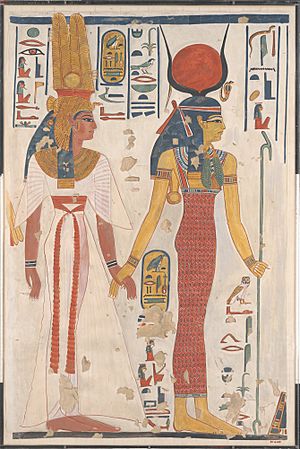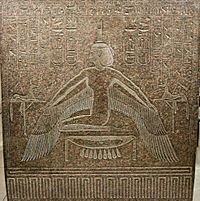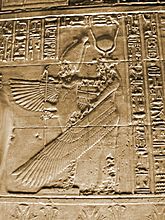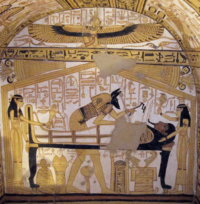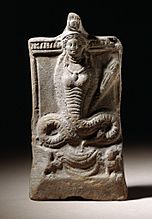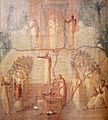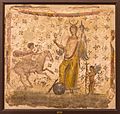Isis facts for kids
Quick facts for kids Isis |
|
|---|---|
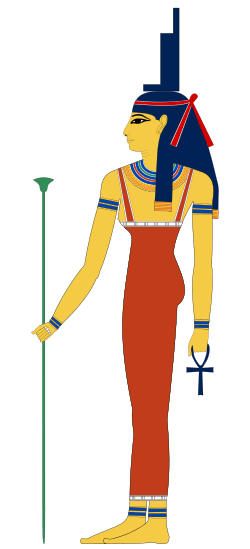 |
Isis (pronounced or eye-sis) was a goddess in Egyptian mythology. She was the wife of Osiris, and they had a son named Horus. Isis also protected children and was one of the greatest goddesses. She is also considered as the greatest magician and goddess of magic.
Isis was prominent in magical texts from the Middle Kingdom onward. The dangers Horus faces in childhood are a frequent theme in magical healing spells, in which Isis's efforts to heal him are extended to cure any patient. In many of these spells, Isis forces Ra to help Horus by declaring that she will stop the sun in its course through the sky unless her son is cured.
In the fourth century BCE, Nectanebo I of the Thirtieth Dynasty claimed Isis as his patron deity, tying her more closely to political power.
Cleopatra III, in the second century BCE, used Isis's name in place of her own in inscriptions, and Cleopatra VII, the last ruler of Egypt before it was annexed by Rome, used the epithet "the new Isis".
In Roman times, Egyptians across the country celebrated her birthday, the Amesysia, by carrying the local cult statue of Isis through their fields, probably celebrating her powers of fertility. The priests at Philae held a festival every ten days when the cult statue of Isis visited the neighboring island of Bigeh, which was said to be Osiris's place of burial, and the priests performed funerary rites for him.
Contents
Origin of the name
The English pronunciation used, comes from the pronunciation of the Greek name, Ίσις, which changed the Egyptian name by adding a final "-s" because of the grammatical requirements of Greek noun endings.
Family
Isis belonged to the family of nine deities descended from the creator god, Atum or Ra. She and her siblings—Osiris, Set, and Nephthys—are the last generation of the Ennead, born to Geb, god of the earth, and Nut, goddess of the sky. The creator god, the world's original ruler, passes down his authority through the male generations of the Ennead, so that Osiris becomes king. Isis, who is Osiris's wife, is his queen.
History
Isis was first mentioned in the Old Kingdom (c. 2686 – c. 2181 BCE) as one of the main characters of the Osiris myth, in which she resurrects her slain brother and husband, the divine king Osiris, and produces and protects his heir, Horus. She was believed to help the dead enter the afterlife as she had helped Osiris, and she was considered the divine mother of the pharaoh.
In the first millennium BCE, Osiris and Isis became the most widely worshipped Egyptian deities, and Isis absorbed traits from many other goddesses. Rulers in Egypt and its southern neighbor Nubia built temples dedicated primarily to Isis, and her temple at Philae was a religious center for Egyptians and Nubians alike. Her reputed magical power was greater than that of all other gods, and she was said to protect the kingdom from its enemies, govern the skies and the natural world, and wield power over fate itself.
In the Hellenistic period (323–30 BCE), when Egypt was ruled and settled by Greeks, Isis was worshipped by Greeks and Egyptians, along with a new god, Serapis. Their worship diffused into the wider Mediterranean world. Isis's Greek devotees ascribed to her traits taken from Greek deities, such as the invention of marriage and the protection of ships at sea, and she retained strong links with Egypt and other Egyptian deities who were popular in the Hellenistic world, such as Osiris and Harpocrates.
Herodotus, a Greek who wrote about Egypt in the fifth century BCE, likened Isis to Demeter, whose mythical search for her daughter Persephone resembled Isis's search for Osiris. Demeter was one of the few Greek deities to be widely adopted by Egyptians in Ptolemaic times, so the similarity between her and Isis provided a link between the two cultures.
As Hellenistic culture was absorbed by Rome in the first century BCE, the cult of Isis became a part of Roman religion. Her devotees were a small proportion of the Roman Empire's population but were found all across its territory. Her following developed distinctive festivals such as the Navigium Isidis, as well as initiation ceremonies resembling those of other Greco-Roman mystery cults. Some of her devotees said she encompassed all feminine divine powers in the world.
The worship of Isis was ended by the rise of Christianity in the fourth through sixth centuries CE.
In Egyptian mythology
When Set kills Osiris, Isis and Nephthys, along with other deities, search for the pieces of his body and reassemble it. Their efforts are the mythic prototype for mummification and other ancient Egyptian funerary practices.
Isis is the epitome of a mourning widow. Her and Nephthys's love and grief help restore Osiris to life, as does Isis's recitation of magical spells. When Isis finally restores breath and life to Osiris's body, she gives birth to their son, Horus. After this point Osiris lives on only in the Duat, or underworld. But by producing a son and heir to avenge his death and carry out funerary rites for him, Isis has ensured that her husband will endure in the afterlife.
Isis gives birth to Horus and must protect him from Set and many other hazards—snakes, scorpions, and simple illness. According to one story, seven minor scorpion deities travel with and guard her. They take revenge on a wealthy woman who has refused to help Isis by stinging the woman's son, making it necessary for the goddess to heal the blameless child. Isis's reputation as a compassionate deity, willing to relieve human suffering, contributed greatly to her appeal.
Powers
Isis was a powerful magician and protector. One great example of her powers is when Isis brought Osiris back to life for one night. Her actions in protecting Osiris against Set became part of a larger, more warlike aspect of her character. New Kingdom funerary texts portray Isis in the barque of Ra as he sails through the underworld, acting as one of several deities who subdue Ra's archenemy, Apep. Kings also called upon her protective magical power against human enemies. In her Ptolemaic temple at Philae, which lay near the frontier with Nubian peoples who raided Egypt, she was described as the protectress of the entire nation, more effective in battle than "millions of soldiers", supporting Ptolemaic kings and Roman emperors in their efforts to subdue Egypt's enemies.
Isis was "more clever than a million gods". She uses these abilities to outmaneuver Set during his conflict with her son. On one occasion, she transforms into a young woman who tells Set she is involved in an inheritance dispute similar to Set's usurpation of Osiris's crown. When Set calls this situation unjust, Isis taunts him, saying he has judged himself to be in the wrong. In later texts, she uses her powers of transformation to fight and destroy Set and his followers.
On one occasion, Isis creates a snake that bites Ra, who is older and greater than she is, and makes him ill with its venom. She offers to cure Ra if he will tell her his true, secret name—a piece of knowledge that carries with it incomparable power. After much coercion, Ra tells her his name, which she passes on to Horus, bolstering his royal authority. The story may be meant as an origin story to explain why Isis's magical ability surpasses that of other deities, but because she uses magic to subdue Ra, the story seems to treat her as having such abilities even before learning his name.
Isis's power over nature was believed to nourish humans, the blessed dead, and the gods.
Roles
Isis's role in afterlife beliefs was based on Osiris's myth. She helped to restore the souls of deceased humans to wholeness as she had done for Osiris. Like other goddesses, such as Hathor, she also acted as a mother to the deceased, providing protection and nourishment.
Isis's most important function, however, was that of a deity that protected Egypt and endorsed its king. She was viewed as the mother and wife of kings. Temple reliefs show Iris nursing the king, which symbolized his divine right to rule. She was also one of the deities who protected and assisted the king in the afterlife.
Isis was also connected with rain, which Egyptian texts call a "Nile in the sky". As the provider of rain, she enlivened the natural world.
In the Greco-Roman world, Isis was often associated with marriage and parenthood. She was invoked to protect women in childbirth. She was often characterized as a cosmic goddess. People believed she organized the behavior of the sun, moon, and stars, governing time and the seasons which, in turn, guaranteed the fertility of the earth. These texts also credit her with inventing agriculture, establishing laws, and devising or promoting other elements of human society.
Isis also oversaw seas and harbors. Sailors left inscriptions calling upon her to ensure the safety and good fortune of their voyages. In this role she was called Isis Pelagia, "Isis of the Sea", or Isis Pharia, referring to a sail or to the island of Pharos, site of the Lighthouse of Alexandria. Isis therefore guaranteed fertile harvests and protected the ships that carried the resulting food across the seas—and thus ensured the well-being of the empire as a whole. Her protection of the state was said to extend to Rome's armies, much as it was in Ptolemaic Egypt, and she was sometimes called Isis Invicta, "Unconquered Isis". Her roles were so numerous that she came to be called myrionymos, "one with countless names," and panthea, "all-goddess".
Physical Appearance
Isis had a sun disk on her head. She appeared as a queen. Sometimes, Isis is called the egg of the goose because Geb is the father of Isis and goose represents him. She also had a throne on her head to symbolize she was a queen.
In Ancient Egyptian art, Isis was most commonly depicted as a woman with the typical attributes of a goddess: a sheath dress, a staff of papyrus in one hand, and an ankh sign in the other. Her original headdress was the throne sign used in writing her name. She and Nephthys often appear together, particularly when mourning Osiris's death, supporting him on his throne, or protecting the sarcophagi of the dead.
Isis sometimes appeared in other animal forms: as a sow, representing her maternal character; as a cow, particularly when linked with Apis; or as a scorpion. She also took the form of a tree or a woman emerging from a tree, sometimes offering food and water to deceased souls.
-
Winged Isis at the foot of the sarcophagus of Ramesses III, twelfth century BCE
Worship of Isis
Many Egyptian gods and goddesses started in one place, and all through their history had their own city where they were worshipped, and many big cities and towns are known as the hometowns of their god or goddess. However, no local cities where Isis was worshipped have been found; all through her early history there are no known temples to her. Worship of Isis did not start until as late as the 30th dynasty; until that time Isis was worshiped in temples of other gods or goddesses. However, even in the 30th dynasty Isis was worshiped together with Horus and Osiris. Temples to Isis became common in the Roman times. There was a temple built to her at Philae.
Its construction began during the Thirtieth Dynasty and was completed or enlarged by Ptolemaic kings. Many other temples of Isis sprang up in Ptolemaic times, ranging from Alexandria and Canopus on the Mediterranean coast to Egypt's frontier with Nubia.
In many places her followers took over the worship to the Semitic goddess Astarte, because of the similarity of names. In the Hellenic era, because she was known as a protector, and mother, she also became the goddess of sailors.
Temples to Isis were built in Iraq, Greece, Rome, even as far north as England where the remains of a temple were found at Hadrian's Wall. At Philae, she was worshiped until the 6th century, after the rise of Christianity. The fall of her temples is usually said to mark the end of ancient Egypt.
Hundreds of thousands of amulets and votive statues of Isis nursing Horus were made during the first millennium BCE, and in Roman Egypt she was among the deities most commonly represented in household religious art, such as figurines and panel paintings.
Priesthood
Little information on Egyptian priests of Isis has been found, but we know that there were both priests and priestesses of her followers all through her history. By the Graeco-Roman era, many of them were healers, and were said to have many other powers, including explaining dreams and the power to control the weather by braiding or combing their hair.
Influence in later cultures
The memory of Isis survived the extinction of her worship. Like the Greeks and Romans, many modern Europeans have regarded ancient Egypt as the home of profound and often mystical wisdom, and this wisdom has often been linked with Isis.
Among modern Egyptians, Isis was used as a national symbol during the Pharaonism movement of the 1920s and 1930s, as Egypt gained independence from British rule. In works such as Mohamed Naghi's painting in the parliament of Egypt, titled Egypt's Renaissance, and Tawfiq al-Hakim's play The Return of the Spirit, Isis symbolizes the revival of the nation. A sculpture by Mahmoud Mokhtar, also called Egypt's Renaissance, plays upon the motif of Isis's removing her veil.
Isis is found frequently in works of fiction, such as a superhero franchise, and her name and image appear in places as disparate as advertisements and personal names. The name Isidoros, meaning "gift of Isis" in Greek, survived in Christianity despite its pagan origins, giving rise to the English name Isidore and its variants. In the late twentieth and early twenty-first centuries, "Isis" itself became a popular feminine given name.
Images for kids
-
Isis holds the king, Seti I, in her lap, thirteenth century BCE
-
Philae as seen from Bigeh Island, painted by David Roberts in 1838
-
The remains of the temple of Isis on Delos
-
The Temple of Isis in Pompeii
-
Fresco of an Isiac gathering, first century CE. One priest tends a fire while another holds up a vessel of sacred water at the door of a temple flanked by sphinxes.
-
Winged Isis at the foot of the sarcophagus of Ramesses III, twelfth century BCE
-
Bronze figurine of Isis-Fortuna with a cornucopia and a rudder, first century CE
See also
 In Spanish: Isis para niños
In Spanish: Isis para niños



